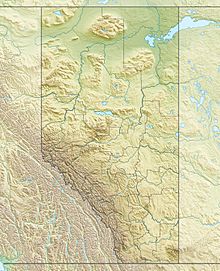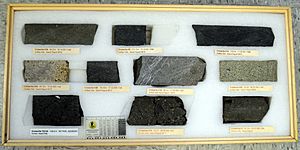Buffalo Head Hills kimberlite field facts for kids
The Buffalo Head Hills kimberlite field is a fascinating area in north-central Alberta, Canada. It's home to many ancient volcanoes that are now filled with a special kind of rock called kimberlite. These rock formations are often shaped like pipes.
Scientists have found 41 of these kimberlite pipes here. What's really cool is that 28 of them contain diamonds! These ancient volcanoes erupted a very long time ago, between about 88 and 60 million years ago.
As of 2014, the Buffalo Head Hills area was still being explored. Companies were trying to figure out the best way to find and collect the diamonds. One of the best spots, called Pipe K252, has a lot of diamonds. It's estimated to have 55 carats of diamonds for every 100 tonnes of rock. That's like finding a lot of treasure!
Contents
Where are the Buffalo Head Hills?
The Buffalo Head Hills (BHH) kimberlite field is located in the Buffalo Head Hills of northern Alberta. It's about 400 km (250 mi) north of the city of Edmonton. This area is part of the larger Northern Alberta kimberlite province, which also includes other similar fields.
The region is covered by the Canadian boreal forest. Not many people live there. You can get to the area by driving on Alberta Highway 88.
How were these ancient volcanoes found?
Deep underground, beneath the Buffalo Head Hills kimberlite field, there's a very old rock layer. It's called the Buffalo Head Terrane and is between 2.0 and 2.4 billion years old! This ancient layer is covered by about 1,600 m (5,200 ft) of younger rocks. On top of that, there's up to 200 m (660 ft) of loose dirt and rocks left behind by glaciers.
Because of all these layers, the kimberlite pipes are hidden deep underground. You can't see them on the surface. So, how did scientists find them? They used special tools! They flew planes over the area to do magnetic and gravity surveys. These surveys helped them find unusual spots underground. Then, they drilled into those spots to confirm if they were kimberlite pipes.
How old are the Buffalo Head Hills kimberlites?
Scientists can figure out the age of rocks using a method called radiometric dating. This method showed that the Buffalo Head Hills kimberlite pipes erupted in two main periods.
The first period was about 81 to 88 million years ago. The second period was about 60 to 64 million years ago. When these volcanoes erupted, the area was actually near the coast of a huge ancient sea. This sea is known as the Late Cretaceous Interior Seaway. Tiny ancient sea creatures found in the mud around some of the kimberlite rocks help confirm how old they are.
What are the rocks like?
The kimberlite pipes in the Buffalo Head Hills vary in size. Some are as small as one hectare (2.5 acres), while others are as large as 47 hectares (116 acres). These volcanoes were like "maar" volcanoes. This means they had a wide, bowl-shaped crater formed by explosive eruptions. The craters were often filled with water.
When these volcanoes erupted, they threw out ash and rock fragments. These materials settled in layers. Some layers are messy and poorly sorted, while others are fine-grained and neatly layered. There are also deposits where water moved the kimberlite rocks around.
Sometimes, you can find multiple layers of volcanic rock separated by layers of marine mud. This shows that the volcanoes erupted several times. In between eruptions, mud from the ancient sea settled on top.
Why are these kimberlites special?
Most of the kimberlites in the Buffalo Head Hills contain diamonds. This is different from another nearby area, the Birch Mountains kimberlite field, where most of the kimberlites don't have diamonds.
Scientists study the rocks to understand them better. The kimberlites here are known as "Group 1A kimberlites." They have a low amount of carbonate and a lot of fresh olivine crystals.
What about the diamonds?
Scientists have looked at over 700 diamonds from the Buffalo Head Hills. These diamonds come in different colors, from clear to yellow and brown. Most of them are transparent and colorless.
Many of the diamonds have a sharp, eight-sided shape, like two pyramids joined at their bases. This shape is called an octahedron. However, about 45% of the diamonds have a twelve-sided shape, called a dodecahedron. This happens when the original octahedron shape gets partly dissolved.
Sometimes, tiny pieces of other minerals are trapped inside the diamonds. These can include garnet, olivine, clinopyroxene, and rutile.



